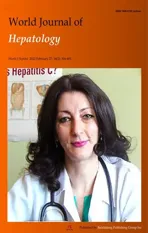COVID-19 and liver disease: Are we missing something?
2022-11-29TaranaGupta
Tarana Gupta
Tarana Gupta, Department of Medicine, Pandit Bhagwat Dayal Sharma Post Graduate Institute of Medical Sciences, Rohtak 124001, Haryana, India
Abstract Since the coronavirus disease 2019 (COVID-19) has hit the world as a pandemic,researchers all over the world have worked on its diagnostics, prognosticating factors, etc. The present study showed liver enzymes, especially aspartate aminotransferase (AST) levels, to be high in non-survivors with raised AST/alanine aminotransferase ratio. Considering the non-specific nature of AST with its presence in organs other than liver such as muscle, heart, kidney and brain makes it difficult to interpret. Even pre-existing metabolic syndrome and non-alcoholic fatty liver disease are confounding factors for deranged liver functions detected during COVID-19 disease. Therefore, the results of the study should be taken with caution.
Key Words: COVID-19; Liver disease; Transaminases; Non-alcoholic fatty liver disease;Hepatocytes; Cholangiocytes
TO THE EDITOR
We read with great interest the article by “Madianet al[1]”. Limited data is available for hepatic injury in coronavirus disease 2019 (COVID-19) disease. Severe acute respiratory syndrome coronavirus 2(SARS-CoV-2) virus causes direct cytopathic effect on hepatocytes. It enters the cell through angiotensin converting enzyme 2 (ACE2) receptors which are ubiquitously present on alveolar epithelium, liver,kidney and blood vesselsetc.ACE2 receptors are present on endothelium of smaller blood vessels in liver, however, sparse on sinusoidal endothelium. Chaiet al[2] reported higher ACE2 expression on cholangiocytes (59%) than hepatocytes (2.6%). They also suggested that liver dysfunction in COVID-19 is predominantly due to cholangiocyte dysfunction. The profound cytokine storm generated by lung injury also results in liver dysfunction. The drug-related hepatotoxicity related to the use of acetaminophen, remdesivir, lopinavir/ritonavir, azithromycinetc.during treatment of COVID-19 disease plays an additive role in causing deranged liver functions[3]. In addition, use of steroids especially in moderate to severe cases can also cause hepatitis B flare in occult hepatitis B patients.
Only a few studies could highlight liver function tests in patients with COVID-19 in non-cirrhotic patients. Limited studies have shown acute liver injury in 14%-53% of COVID-19 cases. In the present study, aspartate aminotransferase (AST) and alanine aminotransferase (ALT) levels were elevated in 31% and 3% among non-survivors respectively with 48% having AST/ALT ratio > 1.2. Zhanget al[4]showed raised AST levels more frequently in intensive care unit (ICU) patients (62%) than in non-ICU(25%) settings. Interestingly, the present study revealed an increased in-hospital mortality up to 11-and 13-fold with AST levels > 1 ULN and > 2 ULN respectively. Chenet al[5] analyzed biochemical profile of 113 deceased and 161 recovered patients in Wuhan, and found abnormal AST levels in 59 (52%)vs25(16%) and lower serum albumin in 74 (65%)vs22 (14%) patients respectively. In the present study,authors also mentioned the possibility of raised AST levels due to muscle injury resulting from profound cytokine storm in COVID-19 illness, though they have documented normal creatine kinase(CK) values indicating liver involvement. AST is an enzyme which is found in liver, muscle, heart,kidney and brain. Therefore, raised AST levels should be taken with caution. The pattern of liver injury in COVID-19 disease is elevated AST levels more than ALT levels with higher gamma-glutamyltransferase (transpeptidase) (GGTP) values which is similar to alcoholic hepatitis.
We should not forget that non-alcoholic fatty liver disease (NAFLD) and obesity are associated with symptomatic, severe and complicated COVID-19 disease and is a potential confounder[6]. The studies assessing the role of liver injury on the course of COVID-19 illness have not screened patients for NAFLD, and we are not aware about their basic liver function tests before COVID-19. A pooled analysis of 8 studies in NAFLD and COVID-19 by Sachdevaet al[7] revealed NAFLD being a predictor of severe COVID-19 disease after adjustment of presence of obesity (OR: 2.3; 95%CI: 1.9-2.9,P< 0.001). Therefore,it may be too early to depend alone on AST levels for the severity and outcome of COVID-19 illness.
FOOTNOTES
Author contributions:Gupta T is the guarantor of the study, written, and revised the manuscript critically for important intellectual content.
Conflict-of-interest statement:I have no conflict of interest.
Open-Access:This article is an open-access article that was selected by an in-house editor and fully peer-reviewed by external reviewers. It is distributed in accordance with the Creative Commons Attribution NonCommercial (CC BYNC 4.0) license, which permits others to distribute, remix, adapt, build upon this work non-commercially, and license their derivative works on different terms, provided the original work is properly cited and the use is noncommercial. See: https://creativecommons.org/Licenses/by-nc/4.0/
Country/Territory of origin:India
ORCID number:Tarana Gupta 0000-0003-3453-2040.
Corresponding Author's Membership in Professional Societies:American Association for the Study of Liver Diseases, No.226223; Indian National Association for the Study of Liver Diseases, No. 1319.
S-Editor:Fan JR
L-Editor:Filipodia
P-Editor:Fan JR
杂志排行
World Journal of Hepatology的其它文章
- Glycogen hepatopathy in type-1 diabetes mellitus: A case report
- Step-up approach in emphysematous hepatitis: A case report
- Learning from a rare phenomenon — spontaneous clearance of chronic hepatitis C virus post-liver transplant: A case report
- Timing of surgical repair of bile duct injuries after laparoscopic cholecystectomy: A systematic review
- β-arrestin-2 predicts the clinical response to β-blockers in cirrhotic portal hypertension patients: A prospective study
- Modified EASL-CLIF criteria that is easier to use and perform better to prognosticate acute-on-chronic liver failure
